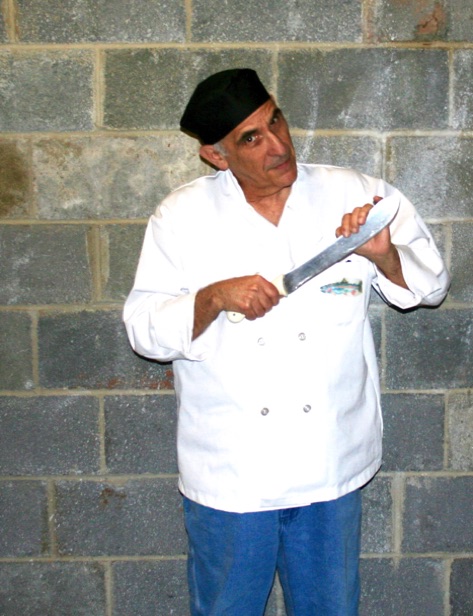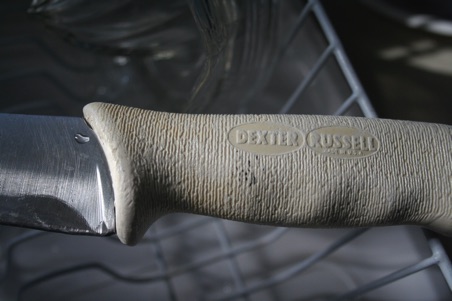Seamless handles molded from synthetic materials eliminate gaps where food remnants hide, and bacteria flourish. Even when wet, they provide a comfortable non-slip grip, reducing lacerations and repetitive strain injuries in the workplace.
Modern commercial knives take and hold a superlative edge. Wiping them on a butcher's steel before, during, and after use (peek in the service window, and watch how often professional meat cutters do this) will keep the edge aligned, and greatly reduces the need for regrinding.
Their blades do not darken or corrode from coming into contact with acidic foods such as tomatoes and lemons. Both handles and blades sail stoutheartedly through the dishwasher, taking high temperatures, strong detergents, and chemical disinfectants in stride.
These knives are manufactured in all traditional patterns to suit each kitchen assignment, and fit every hand. In the unlikely event that one should become damaged, or like Jacques' Sani-Safe, sprout legs and walk off the job, it can be easily replaced at no great expense.
A particular cook may prefer the high-visibility yellow handle that makes it harder to swipe somebody's Swiss-made Swibo. Millions around the globe swear by South Bridge, Massachussets-made Dexter-Russell. Though I could be happy with any of these commercial knives, I suppose that if pressed, I'd have to give the nod to Forschner/Victorinox. Their Swiss steel recipe is nothing less than delectable.
On the other hand, If you can afford more expensive knives and are willing to provide them with the additional care they usually require, by all means go for it. Luxury purchases are based mostly on intangibles. But if you think that spending more money on a knife will make you a better cook, you are wasting your money.
For example, let's consider a feature that is frequently found in more expensive knives–a forged blade. Forging is accomplished by heating steel in an oven until it becomes ductile (soft), then hammering it into the desired shape. (This operation is no longer performed by the village smithy, but by automated machinery.)
With its crystalline structure rearranged by the heating and hammering, a forged blade will resist blows and bending better than one that has been cut or stamped out of sheet metal. And everything being equal, the forged knife will be heavier–an advantage or disadvantage, depending on the user's preference. (Manufacturers of knives featuring ceramic and sintered metal blades tout lighter weight among their benefits–see below.) But do not assume that a forged blade will take or retain a keener edge.
When fencing with foil or épée, edge sharpness is beside the point. Under such circumstances, the superior strength of a forged blade could make the difference between a raffish dueling scar, and a sucking chest wound. (In any event, I earnestly hope that my readers will not attempt to settle their affairs of honor in the kitchen, but take them out where they belong–the parking lot.)
The blades of modern scalpels are no longer forged, but are cut from stainless steel. Needles to say, they are excruciatingly sharp. It is worth noting, however, that the sharpest scalpels on earth–five hundred times sharper than the keenest surgical steel–are knapped by hand, one at a time, from obsidian, a naturally occurring volcanic glass–exactly the way the first blade was made, two and a half million years ago!
Let us now return to the present, and consider the cutting edge of technology–blades produced by metal and ceramic sintering. To create a sintered blade, ceramic or metal powders are placed in a mold. Subjected to tremendous heat and pressure, the powder coalesces into a solid, without first passing through a liquid or molten stage. The hardness of a sintered blade can approach that of a diamond–but unfortunately, so can the price.
Like our obsidian scalpel, sintered blades are extremely brittle. No matter how carefully you use them, they are born to break. If you could manage to keep one intact, a sintered blade would retain its sharpness longer than a conventional one. But while a conventional blade's edge can usually be restored with a few quick swipes on a butcher's steel, a sintered knife must be sent away to be professionally re-sharpened. À chacun son goût, then, with a double side order of caveat emptor.
The butcher's steel, sometimes referred to as chef's steel, sharpening rod, or just steel, is the other half of the knife itself. It is not meant to create a new edge, but rather to recondition an edge that has only been temporarily misplaced.
To better understand this, imagine the knife edge as a microscope would see it. Through the lens, it resembles a thin piece of foil. When pressure is applied, it folds over, forming a burr. If we up the magnification, we will see that the burr itself is not smooth, but a long row of shark-like teeth. When the knife is wiped along the steel, the burr is made straight again, any loose teeth are removed, and the edge regains its bite.
Steels vary in length, smoothness, cross section, and hardness. The longer the steel, the easier it is to use. Its length should equal or exceed the length of the longest knife used with it. Twelve inches, not including the handle, is good. Fourteen inches is better.
The steel's surface may be smoothly polished, or fashioned with grooves running parallel to its length. A smooth steel works more gently, and is best suited for use with knives that are never allowed to become dull. A grooved steel is more effective for bringing up the edge of dull knives.
In cross section, steels may be round or elliptical. The elliptical shape offers two contact areas. The side with the shorter radius is for gentle honing, while the other is for more vigorous reconditioning. In recent years, diamond-coated and ceramic sharpening rods have become popular. In addition to aligning the edge, the diamond-coated rod is capable of removing enough steel to change the geometry of the blade, and so must be used with some care. Ceramic rods must be used carefully, too, because like ceramic knive, they are almost certain to break if dropped on a tile floor or granite countertop.
In a pinch, the back of a cheap, hard stainless steel knife such as a Ginsu makes a passable steel. And I have honed many a blade to wicked sharpness using nothing more than the unglazed ceramic rim on the back of a dinner plate.
But hopefully, you will leave your William and Kate wedding china in the sideboard, and invest in a proper butcher's steel. In addition to the qualities we have already discussed, make sure that your purchase is provided with an adequate guard between handle and rod. Then, if you are planning to use it in the conventional manner, be sure that you already possess at least as many fingers as you ever expect to really need.
Most sources recommend gripping the steel in your less-dominant hand, with the point facing away from you. (So far, so good.) Then, holding the knife in your dominant hand with the blade facing your body, you are enjoined to draw the blade in a sweeping motion toward the hand holding the steel.
Happily, there is a better and safer way. Think about sharpening a pencil. Do you pull the blade towards yourself, or push it away? Just imagine that your steel is the pencil. Use the knife just as you would if you were sharpening a pencil with it. Try to maintain an angle of between 15- and 20-degrees. You'll quickly get a feel of it.
But regardless of how faithfully you keep your knife aligned with the steel, it will eventually need its dull old edge replaced by a sharp, shiny new one. The three ways that this can be accomplished are with sharpening stones, electric machines, and hand-held carbide sharpeners.
The sound and rhythm of the blade as it glides across the face of a stone can be meditative. It's not a difficult skill to learn. And no automated or more convenient method can produce an edge equal to one created on a stone. However, it requires both practice, and patience.
Sharpening stones are often referred to as whetstones. This term has nothing to do with water, but comes from the verb "whet," meaning to sharpen. Some whetstones are cut from naturally occurring minerals, such as the world-famous Arkansas stone (Novaculite). Coticule, a stone from the Ardennes, a vast forest occupying parts of France, Belgium and Luxembourg, also has its partisans. Britain's Charnwood Forest has been a source of whetstones for centuries, and the Narutaki District of Japan has been grinding them out for hundreds of years.
After epochs of exploitation, our planet's supply of natural whetstones has become exhausted, and the resulting scarcity has driven up their cost dramatically. Fortunately, there are many reasonably priced man-made alternatives that sharpen just as well.
Most of these are made from aluminum oxide, silicon carbide (carborundum), or industrial diamonds embedded in steel. All are graded by "grit" or "grit size." A grit of 250 is fairly coarse, and one of 1,000 fairly fine. Like their makers, man-made stones are typically two-faced, featuring a coarse side, and a finer one.
The larger the stone, the easier it is to use. For sharpening kitchen knives, a stone should be six to eight inches long, and two or three inches wide.
No oils or petroleum-based solvents should ever come in contact with knives or sharpening stones used for food preparation. Cooking oils will clog the stone's surface, then become rancid. All stones used to sharpen kitchen knives, including so-called oil stones, should be lubricated only with water, a solution of water and dish detergent, or pure, undiluted dish detergent.
Two- and three-stage electric sharpeners have become very popular, some bearing the names of famous knife manufacturers. All those that I have tried produced results that were just adequate at best.
Without a doubt, the fastest and easiest way to sharpen virtually any knife is with one of the cheap, hand-held gizmos that use crossed carbide steel elements. They require neither electricity, nor skill. A few passes from butt to tip produces a radically sharp edge. Two recommendable examples are the AccuSharp 001, and the Lansky PS-MED01 BladeMedic.
In the process, however, carbide sharpeners do remove quite a bit of metal. You can almost see the steel coming off in curls like soft pine from a carpenter's plane. With commercial knives, this is unconcerning. But if you spent a considerable amount on fancy knives, the little piles of steel shavings might be unsettling.
In order to do their job, the butcher's steel and sharpening stone used to maintain your knife's edge must be harder than the blade itself. The harder the surface you cut on, however, the more quickly your knife will be dulled. Glass, Corian and the like are totally unsuitable materials for cutting boards.
In addition to being easy on the edge, a cutting board must be both durable, and sanitary. The choice narrows down to wood, or plastic.
Intuitively, it seems obvious that wood must provide a much cozier environment for bacteria than nonporous plastic. But a famous California University study showed how such common sense assumptions may be wrong.
In 1994, Dr. Dean O. Oliver and his team at the University of California's Davis Campus contaminated some cutting boards, both wood and plastic, for experimental purposes. To everyone's surprise, the surface of the wooden boards harbored significantly fewer bacteria than the plastic ones. They found that the porous wood wicked the bacteria below the boards' surface, where they dried up, stopped reproducing, and soon died. But on the plastic boards' nonporous surface, the bacteria just lounged around, proliferating shamelessly.
Other scientists conducting similar experiments came to opposite conclusions. Writing in the May 2, 1994 Journal of Food Safety, S. H. Abrishami stated "Results corroborated the anecdotal belief that bacteria are better retained on wooden than plastic cutting board surfaces."
In addition to pathogens like salmonella and e. coli, cutting boards are potential vectors for allergens such as peanuts, fish, shellfish, and gluten. In sensitive individuals, exposure to even tiny amounts of these substances can trigger a violent reaction, and even cause death.
NSF International, the highly respected not-for-profit testing agency headquartered in Ann Arbor, Michigan, enjoins us to "Make sure your cutting boards are made of non-porous material or plastic." In any case, Dr. Cliver doesn't stipulate whether the wooden cutting boards in his study were of edge-grain or end-grain construction. From a knife's point of view, as well as a bacterium's, the difference is night and day.
End-grain cutting boards display the familiar checkerboard pattern that results from the grain orientation of the individual pieces of wood from which it is constructed. The pieces are glued together so the grain runs vertically, like the fibers in a living tree. Through capillary action, water and nutrients are absorbed into the roots, and taken up the trunks into the branches and leaves.
From the knife's point of view, the end-grain is like a dense brush. On the downstroke, the fibers spread apart to make way for the blade instead of resisting it. That's why end-grain cutting boards cause the least wear to the knife's edge. When the blade is lifted off the board, the fibers regroup in a way that is sometimes referred to as "self healing."
This should not be confused with edge-grain construction, where individual pieces are glued together with their grain running horizontally. Edge-grain cutting boards, then, do not possess the ability to heal themselves, and they aren't particularly easy on the blade. Neither are their surfaces absorbant in the manner of end-grain boards.
If an end-grain board has any hope of not splitting or warping, it needs to be as thick as possible in relation to its surface area. A round board of useful size–say, eighteen inches in diameter–needs to be two or three inches thick. It will weigh twenty to twenty-five pounds, and cost anywhere from one hundred and twenty-five to two hundred dollars. In order to retain their functional qualities, all wooden boards should be rubbed with a mixture of mineral oil and beeswax once a week.
Good food safety practice mandates that all soiled boards, wood or plastic, be brought to the sink, and washed in hot, soapy water with a stiff brush. Afterwards, distilled white vinegar should be applied with a spray bottle, and the board be allowed to air dry.
Drying is best accomplished by leaning the board against a wall so air has access to both sides. White vinegar, full strength or in a 1:3 dilution with water, has been proven to outperform bleach, hydrogen peroxide, and purpose-made commercial disinfectants (quaternary ammonium solutions) by a wide margin in killing bacteria, and has the additional benefits of being nonirritating, nontoxic, and hypoallergenic.
One of the best strategies for preventing food-borne illness is to use separate boards for chicken, red meat, fish, and vegetables. Using boards of different colors further reduces the likelihood of cross contamination.
For most of us, owning several large, end-grain hardwood cutting boards is not a practical option. Even if you could afford to buy them, where would you find the counter space to display them, or the cabinet space to store them? Not to mention the muscle and discipline to schlep them to the sink and back every time you use them.
It is my recommendation, then, that plastic cutting boards be used for all actual food preparation. Then your wooden boards can be reserved to display and serve fruit, bread, cheese, and other low-moisture items. In that way, wood's functional limitations cease to be an issue, and its unparalleled warmth and beauty can be fully appreciated. In the same spirit, a fancy knife, selected for its aesthetic qualities, can be set aside for cutting up on the holidays and other special occasions. (Carve your turkey on plastic, and serve it on china.)
Now that we have the information we need to choose our weapons, it's time to shut down the computer, turn off the television, and close the foodie magazine. Cooking has nothing to do with custom cabinets and granite countertops. It's not for spectators or dilettantes, sissies or prima donnas. And so, as we march arm in arm onto the battlefield, always remember: the Battle of Pork Chop Hill won't be decided by your steel, but by your mettle. Desperto ferro, and Oo-rah!



